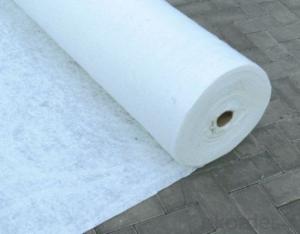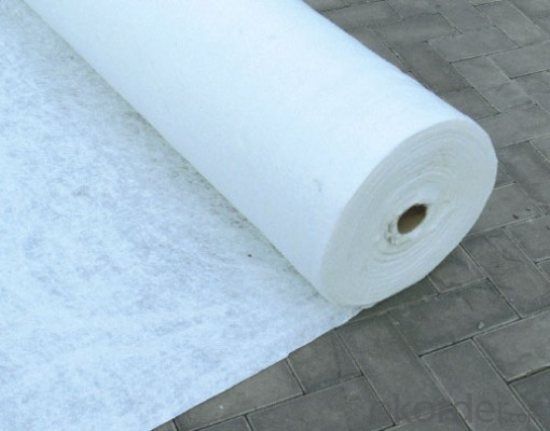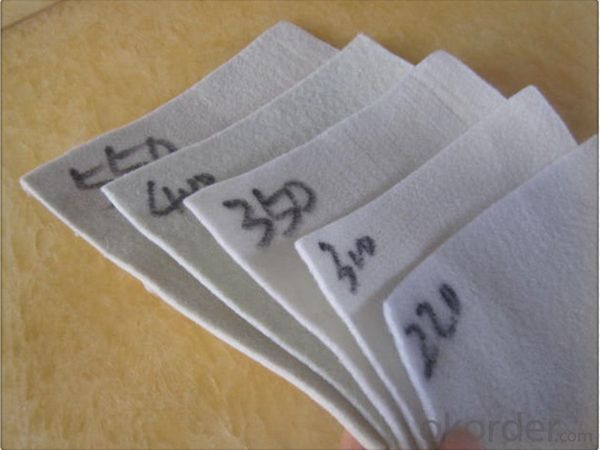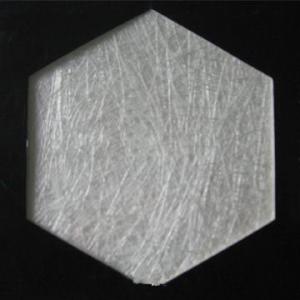Toile Geotextile for Pet Needle Punched Applications in Architectural Engineering
- Loading Port:
- Qingdao
- Payment Terms:
- TT or LC
- Min Order Qty:
- 8000 m²
- Supply Capability:
- 100000 m²/month
OKorder Service Pledge
OKorder Financial Service
You Might Also Like
PET Needle Punched Geotextile for Architectural Engineering
Description Of PET Needle Punched Geotextile for Architectural Engineering
PET needle punched geotextile is made from PP or PE materials by melting down, fiber-drawing, and cutting into 4-9 dtox, 50-76mm PP fibre before carding, lapping and weaving into needle punched non woven fabric.
Main Features of PET Needle Punched Geotextile for Architectural Engineering
Good tenacity, high density, loose structure, anti-corrosion, anti-aging, acid-and-alkali-resistance, good water absorption and permeability, high tensile strength
Applications of PET Needle Punched Geotextile for Architectural Engineering
Used in the area of highway, railway, dam, coastal beach for reinforcement, filtration, separation and drainage, especially used in salt marshes and garbage burying field.
IMages of PET Needle Punched Geotextile for Architectural Engineering




FAQ:
1. What are we supplying?
We are specialized in producing .geotextile , geocell, geogrid, geomembrane
2. How Many years experience do we have?
We have been exported to more than 15 countries in the past 15 years.
3. How long do we usually reply your request?
We always reply our customer within 4 hours.
- Q: How do geotextiles improve the performance of geotubes?
- Geotextiles improve the performance of geotubes by providing reinforcement and filtration. They act as a barrier to prevent the loss of soil particles while allowing water to pass through, thereby enhancing the stability and strength of geotubes. Additionally, geotextiles help distribute loads evenly, reducing the risk of erosion and increasing the overall performance and longevity of geotubes.
- Q: How do geotextiles improve the performance of drainage systems?
- Geotextiles improve the performance of drainage systems by enhancing filtration, preventing soil erosion, and promoting water flow, thus increasing the overall efficiency and longevity of the drainage system.
- Q: Can geotextiles be used in landfill construction?
- Yes, geotextiles can be used in landfill construction. They are often used as a barrier or liner material to separate the waste from the underlying soil and prevent leachate from contaminating the surrounding environment. Geotextiles can also be used to reinforce the landfill slopes and prevent erosion.
- Q: Are geotextiles resistant to biological clogging?
- Yes, geotextiles are generally resistant to biological clogging. They are designed to allow water to pass through while preventing the movement of soil particles. This characteristic helps to minimize the growth of organisms, such as bacteria and algae, that can cause clogging. However, it's important to note that the level of resistance may vary depending on the specific type and quality of geotextile used.
- Q: What are the specifications for geotextiles used in transportation projects?
- The specifications for geotextiles used in transportation projects generally include criteria such as tensile strength, puncture resistance, thickness, permeability, and durability. These specifications ensure the geotextiles can effectively separate, reinforce, and filter materials in road construction, preventing the mixing of soil layers, enhancing stability, and improving drainage.
- Q: Geotextile what role
- The role of geotextile 1. Highway and railway construction for the separation of reinforced geotextile drainage; 2. Bank slope dam reinforcement geotextile; bridge engineering geotextile; waste piling pool; artificial pool with impermeable geotextile; cloth. 3. The effect of geotextile is: 1. The application of reinforcement can be stable, limit the displacement of civil engineering in the long-term use, and can make the local stress transfer or distribution in the soil To a larger area, to increase the friction between the soil and geotextile resistance. 2. Application of isolation with geotextile to separate the different soil structure, the formation of a stable interface, so that the structure of the separation of layers, in accordance with the requirements to play their respective characteristics and the overall role of 3. Protective effect of geotextile soil or Water, can play the role of protection and anti-fog, 4. the role of the application of geotextile soil can let the water through, but also effectively prevent the passage of soil particles, so as to prevent the loss of soil particles caused by soil damage, The application of non-woven geotextile in the soil can form a drainage channel, the soil together in the water, along the plane of the material out of the body. 5. Application of seepage prevention Geomembrane and composite geotextile material, can prevent the leakage of liquid, gas evaporation, environmental protection or building safety.
- Q: Polyester geotextile price how much
- Is there a scientific name? Added: Will not it be filament geotext? This is what we have, but the scientific name does not call you this!
- Q: Can geotextiles be used in the protection of culverts?
- Yes, geotextiles can be used in the protection of culverts. Geotextiles are often used as a protective barrier around culverts to prevent soil erosion and filter out any sediments that may clog or damage the culvert. They provide an effective solution for enhancing the longevity and stability of culverts.
- Q: Filament non-woven geotextile, geomembrane, how much need to use third-party testing?
- This depends on the party and the supervision requirements, and generally 1-2 million square a test batch, I am specializing in the production of geotechnical materials
- Q: Can geotextiles be used in geotechnical engineering?
- Yes, geotextiles can be used in geotechnical engineering. Geotextiles are commonly used in geotechnical engineering for applications such as soil stabilization, erosion control, filtration, drainage, and reinforcement. They provide various benefits such as improved soil strength, increased load-bearing capacity, and enhanced drainage capabilities. Geotextiles are versatile and widely employed in a range of geotechnical projects, including road construction, retaining walls, landfills, and slope stabilization.
Send your message to us
Toile Geotextile for Pet Needle Punched Applications in Architectural Engineering
- Loading Port:
- Qingdao
- Payment Terms:
- TT or LC
- Min Order Qty:
- 8000 m²
- Supply Capability:
- 100000 m²/month
OKorder Service Pledge
OKorder Financial Service
Similar products
Hot products
Hot Searches
Related keywords



































